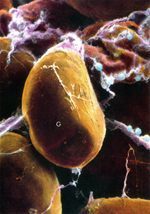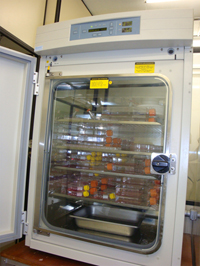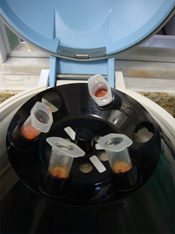At the 2010 annual ASPS plastic surgery meeting in Toronto, I listened to Dr. Alexandra Condé Green’s research presentation which concluded that 1) you can find quantities of stem cells using centrifugation techniques only – without the use of collagenase, 2) the pellet at the bottom of the tube contains the highest % of stem cells and 3) stem cell enhanced fat grafting is better than regular fat grafting.
After she presented her paper, Dr. Peter Rubin, University of Pittsburgh Plastic Surgery Chief, (aka Mr. Stem Cell) said: ‘Dr. Condé Green – what you are proposing is quite provocative.’
We believe that Dr. Rubin was referring to her findings that you can obtain stem cells by simply centrifuging the fat. This would be the golden ‘minimal manipulation’ that could keep the FDA out of reach because these stem cells would not be classified as a drug! Dr. Condé Green, a plastic surgeon working with Dr. Pitanguy’s lab in Brazil, is onto something big here and I have invited her to share her results with you. Please see her comments below.
Techniques for stem cell enhanced fat grafting

Autologous fat graft is considered nowadays the ideal soft-tissue filler because it is abundant, host compatible, and can be harvested easily and repeatedly. However many variations in long-term results of transplanted adipose tissue have been reported due to absorption and volume loss. Careful measures are employed to harvest, process and inject the fat in order to get the best possible intake. Still there is no consensus on the best method to prepare the fat and many controversies exist among these different steps.
Also, we have yet to know which part of the adipose tissue is more important for the graft take, the adipocytes, the other cells (stem cells, endothelial cells) or both.(Fig 1)
New evidence points to an improvement in vascularity and blood flow when stem cells are more concentrated in the fat to be transplanted. For therapeutic approaches, reproducible protocols of adipose-derived stem cells isolation and a large amount of cells are necessary, in order to respond to the increasing demand. Therefore, to practically understand what happens when adipose tissue is manipulated in the operating room, we studied the most common methods of fat processing employed by most plastic surgeons, in order to see which method yields the highest quantity of stem cells¹.
Fat harvesting and processing
Under loco regional anesthesia, we aspirated adipose tissue from the inferior abdomen of healthy adult females undergoing liposuction with a blunt 3 mm cannula attached to a 10 ml Luer-lock syringe, using the superwet technique (at a rate of 1 ml of a solution containing normal saline with 1:1,000,000 of epinephrine per milliliter of aspirated tissue).

The lipoaspirates were separated into three samples that were processed by decantation (under the action of gravity in the syringe), washing with normal saline (in a ratio of 1:1 (vol/vol), 3 times) and centrifugation at 3,000 rpm/ 1,200g for 3 minutes.
Each processed lipoaspirate yielded three layers: a superior layer composed of an oily liquid, a middle layer consisting of a firmer yellow tissue and an inferior layer composed mostly of blood, infiltration or washing liquids.
In addition, another 4th layer, the pellet, was identified at the bottom of the centrifuged lipoaspirate².
After discarding the superior oily layer, the middle layer of each processed sample plus the pellet of the centrifuged samples were processed by mechanical dissociation in order to isolate the Mechanically Processed lipoaspirated cells (MPLA) from the adipocytes.
Cells were cultured during one week and subsequently induced to the adipogenic lineage.(Fig 2)
They were analyzed by flow cytometry after incubation with monoclonal antibodies in order to assess their viability.

Results
The quantification of the viable cells isolated revealed an expressive loss in the middle layer of the centrifuged samples (Figures 3 and 4); also the culture of these stem cells did not reach the adipogenic phenotype.
However a great concentration was found in the stromal vascular fraction-SVF (the pellet) (Fig 5, illustrated by the green arrow) due to the force of the centifugation process and after one week of adipogenic induction, fully differentiated cells of adipogenic lineage were obtained from this SVF.
Also Stem cells issued from the decanted and washed samples exhibited lipid droplets in their cytoplasm but in lower quantity than in the pellet³.
Conclusion

Fat harvesting and processing techniques employed by plastic surgeons in the operating room play an important role on the viability and integrity of adipose tissue, on the ability of stem cells to proliferate and differentiate during in vitro culture, and per consequence on the viability of fat grafting.
Our results have revealed that centrifugation at an adequate velocity and time, cleans adipose tissue of harmful substances to fat graft but deprives the middle layer of fat tissue (which is usually kept after discarding the superior oily layer and the inferior liquid layer) of viable stem cells. However, the cells which descend in the pellet (SVF) have shown to fully differentiate in cells of adipogenic lineage and represent a rich source of stem cells.
Therefore these cells could be used in order to enrich the middle layer which is poor in stem cells (representing a fat tissue scaffold that would provide mechanical support to cells) in order to increase graft survival. This represents another link in the chain of numerous studies being done to utilize this important source of postnatal MSCs for regenerative medicine applications.
References
- Condé Green A. Optimized autologous fat grafting: Effects of harvesting, manipulation on live mesenchymal stromal cells. Plast Reconstr Surg 126 (): 57-58, Oct 2010 Abstract Supplement. Presented at the American Society of Plastic Surgeons meeting, Plastic Surgery 2010 in Toronto, Canada. Link: https://journals.lww.com/plasreconsurg/Citation/2010/10002/Optimized_Autologous_Fat_Grafting__Effects_of.63.aspx
- Condé-Green A, Borojevic R, Pitanguy, et al. Effects of centrifugation on cell composition [sp edited from composition] and viability of aspirated adipose tissue for transplantation. Aesthetic Surgery Journal, Mar 2010; Volume 30, Issue 2, Pages:249-255. Link: https://doi.org/10.1177/1090820X10369512
- Condé-Green A, Pitanguy I, et al. Influence of decantation, washing and centrifugation on adipocyte and mesenchymal stem cell content of aspirated adipose tissue: a comparative study. Journal of Plastic Reconstructive Aesthetic Surgery, August 2010; Volume 63, Issue 8, Pages:1375-1381. Link: https://www.jprasurg.com/article/S1748-6815(09)00536-1/abstract




Jude says:
Dr. Ricardo L Rodriguez says: